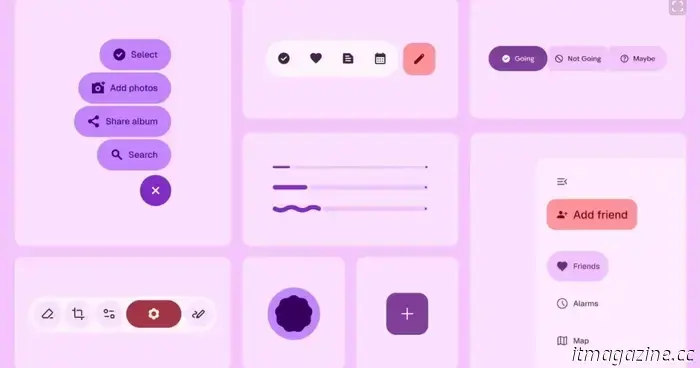
Google has inadvertently revealed images of the forthcoming Android redesign.
Google is set to reveal its new “Material 3 Expressive” design system at I/O 2025 this month. However, a blog post detailing it was mistakenly published this week before being quickly removed. Fortunately, the Wayback Machine captured it, and the resourceful team at 9to5Google saved the accompanying images.
The blog post focuses on the research that informed the new design system for Android 16. Google dedicated three years to various studies and experiments involving over 18,000 participants, which included:
- Eye tracking to determine where individuals concentrate their focus
- Surveys and focus groups for collecting feedback and impressions
- Experiments to identify preferences
- Usability tests to assess how rapidly users can adapt to the interface
As the name suggests, Google aims for an “expressive” design with this system, which seeks to evoke emotions when users interact with the UI. Research indicates this approach resonates well with younger audiences while remaining user-friendly for older individuals.
The blog features images that demonstrate the contrast between expressive and non-expressive design.
One mockup that stands out is of the Gmail app. It feels like email app designs have not evolved and are outdated. There's a desire for a design that showcases images attached and feels tailored for phone use.
Key elements of Material 3 Expressive include large text, prominent buttons, floating toolbars, and a "bold use of shapes and colors." However, the visuals shared by Google are merely conceptual designs—there is currently no final product. Additionally, when manufacturers like Samsung or Nothing create Android phones, they design their own unique UIs that may vary significantly.
Having reviewed the images and learned about the research, the next anticipation is to find out how and when Material 3 Expressive will be rolled out, with hopes that I/O 2025 will provide clarity.
---
Android 16 is advancing rapidly, with a recent third beta update marking a milestone in platform stability. While the latest test version has a few feature updates, it introduces a noteworthy new function. Pixel users can now unlock their devices even with the screen completely off. Initially noted by Android Authority, this new “Screen-off Fingerprint Unlock” option is within the phone’s Security & Privacy dashboard.
Previously, users had to activate the screen and place their thumb on the fingerprint sensor on the Lock Screen, requiring them to wake the screen using a tap or the power button. With the new convenience, users can simply place their thumb on the in-display fingerprint sensor without needing to wake the screen, eliminating the inconvenience of turning on the display.
I successfully activated this feature after installing the Android 16 Beta 3.1 version, which is built on the March 2025 security update, on a Pixel 8 smartphone. This new feature is a thoughtful addition and functions seamlessly. Nonetheless, it does require some practice to position the thumb correctly above the sensor on a dark screen. It’s also important to mention that Google is not the first to offer this feature.
I tested unlocking my OnePlus 13 and Samsung Galaxy S25 without having to wake the screen, and both did so effectively. Currently, they run on Android 15 and provide a quicker fingerprint unlock experience than the Pixel 8, regardless of whether the screen is on or off.
It’s important to note that the screen-off fingerprint unlock feature is part of a beta build, and Google may choose to remove or postpone it when the stable version of Android 16 is widely released in the coming months. For now, users can only experience it by joining the Android 16 beta-testing program on compatible Pixel devices. However, I suggest waiting a few more weeks for the stable update to arrive on your Pixel smartphone to avoid possible issues that come with beta versions.
---
Android 16 will introduce a useful feature for desktop users that allows screen recording of activities on an external monitor. This expands on an existing function in Android 15 that lets you take screenshots of external displays connected to Android devices. According to Android Authority, Android 16 Beta 3 includes a new option in the screen recorder menu: "Record HDMI Screen," functioning similarly to recording the device display and saving the video in the same manner.
---
Recent developments reveal that Google Assistant is being replaced by Gemini, leading to the quiet retirement of several features. While some will transition to Gemini, devices lacking immediate access to the new AI companion may not have alternative options. As reported by 9to5Google, Google Assistant will be losing a total of seven features, impacting users on Android devices, Nest Hub, and Nest speakers.








Other articles
 As game prices increase, I need to become a more selective player.
The cost of video games is increasing, which is prompting more players to be careful and thoughtful shoppers.
As game prices increase, I need to become a more selective player.
The cost of video games is increasing, which is prompting more players to be careful and thoughtful shoppers.
 Ram brings back the 1500 Express trim as a budget-friendly choice.
Ram is bringing back the Ram 1500 Express trim as a budget-friendly choice.
Ram brings back the 1500 Express trim as a budget-friendly choice.
Ram is bringing back the Ram 1500 Express trim as a budget-friendly choice.
 Waymo is establishing the foundation for a revolution in robotaxis.
It’s a lengthy journey, but Waymo is slowly progressing towards its long-aspired objective.
Waymo is establishing the foundation for a revolution in robotaxis.
It’s a lengthy journey, but Waymo is slowly progressing towards its long-aspired objective.
 I was so fond of these speakers that I injured myself while attempting to repair them.
When my 15-year-old Harman Kardon speakers began to malfunction, I realized I needed to attempt a repair. However, it turned out to be in vain.
I was so fond of these speakers that I injured myself while attempting to repair them.
When my 15-year-old Harman Kardon speakers began to malfunction, I realized I needed to attempt a repair. However, it turned out to be in vain.
 Your upcoming smartphone has received a significant upgrade in performance and battery life.
TSMC plans to begin mass production of 2nm chips by the fourth quarter of 2025.
Your upcoming smartphone has received a significant upgrade in performance and battery life.
TSMC plans to begin mass production of 2nm chips by the fourth quarter of 2025.
 Three rom-coms on Netflix that you should check out in May 2025.
Our selections for three romantic comedies on Netflix to enjoy in May feature a baseball-themed drama, a comedy starring Ryan Gosling, and a delightful tale about an engagement.
Three rom-coms on Netflix that you should check out in May 2025.
Our selections for three romantic comedies on Netflix to enjoy in May feature a baseball-themed drama, a comedy starring Ryan Gosling, and a delightful tale about an engagement.
Google has inadvertently revealed images of the forthcoming Android redesign.
Google inadvertently shared images of its forthcoming Android redesign.
